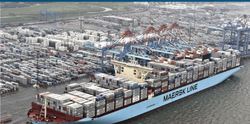India registers double-digit trade growth in Q3 2018

India’s containerised export trade with the world grew a healthy 10% in the third quarter of 2018 (Q3) due to broad- based recovery in the manufacturing sector, globally buoyed by a surge in demand from end-user industries. One of the contributing factors for higher exports is the sharp depreciation of the Indian rupee against the dollar which made Indian products more competitive. Additionally, the investments by Chinese firms to comply with strict environmental norms have increased their cost of production and together with the appreciating yuan, has reduced their production cost advantage, thus benefitting Indian exports.
The high demand for India-made vehicles, mechanical appliances; as well as refrigerated cargo such as seafood and pharmaceuticals, have driven the country’s export growth trajectory. The upswing witnessed by the local manufacturing sector during the last few quarters is reflective of the firming demand for India-made goods, including from non-traditional markets such as Algeria and Nigeria, which also helped to drive export growth. India’s drive to create a new farm export framework to liberalize trade in farm products and grow farm exports via the conclusion of multiple bilateral agreements is expected to yield a positive outcome.
Containerized imports maintained a stable growth of 9%, mainly due to a heavy inflow of paper into the country, along with metals from North American and European countries.
“The upward movement in global commodity prices, depreciation of the Indian rupee and recent major shipping-logistics reforms such as liberalized cabotage policy and Direct Port Delivery are instrumental in supporting the import-export trade between India and global markets. With fast growing trade figures that are significantly higher than the estimated global containerized demand growth (which in fact slowed during Q3), coupled with strategic competitive pricing, India is emerging as a favorable trade destination for both advanced and emerging markets.”
Steve Felder
Managing Director for Maersk Line – South Asia
Strong growth in reefer exports; and large increase in dry commodity imports
Though the export of meat was stagnant, the export of onions witnessed a 15% growth and exports of shrimps grew by 20%, thereby driving overall reefer exports by 27% year-on-year*. The demand for Indian organic food to the United States, the European Union, Canada, Israel and Vietnam has played a part in India’s reefer export development.
Containerised imports of paper, metal and white goods have driven the import of dry commodities by 18% year-on- year*. The import of paper continues in Q3 2018 from the United States, Canada, the United Kingdom and South Korea with an increased demand from the FMCG and packaged food segments, the rapidly growing e-commerce industry and the run-up to the upcoming elections. The surge in paper imports has raised some concerns for local paper manufacturing players, and there is an evaluation of a potential three years anti-dumping on certain kinds of uncoated paper from Indonesia, Thailand and Singapore.